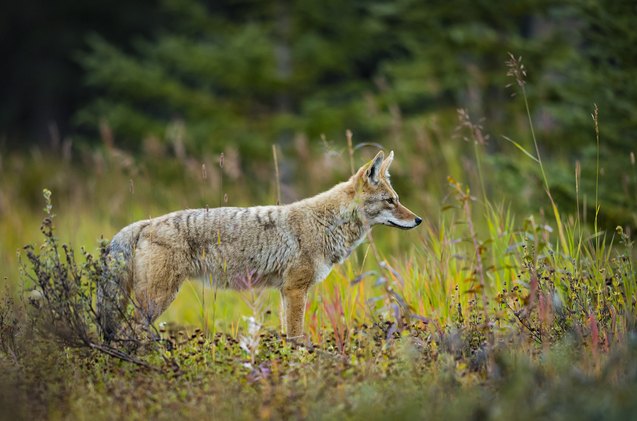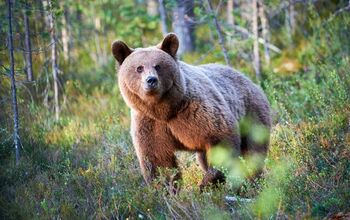5 Tips on Avoiding Coyotes When Walking Your Dog

You know what ruins a perfectly good walk with your dogs? Coyotes! Avoid unpleasant encounters with these five tips from Kevin Roberts.
Early one morning, I was out for a jog with my dogs. Ear buds in, the dogs were off-leash, and we were making good time. I picked an isolated trail, where we were unlikely to encounter anyone else… I didn’t want to upset anyone with my off leash pack.
It was Belle who first cued me that something was off. Leaving my side, hackles up, tail straight out, she jumped towards the long grass barking and snarling. In one deft movement, I leashed the dogs and pulled out my ear buds – ninja mode activated! Checking for the source as to what set Belle off, I scanned the area, but couldn’t spot anything unusual.
A little freaked out, I took off down the trail at a slow jog, all the dogs on leash and my ear buds out. But Belle would not run! She kept looking over her shoulder and pulling me backwards. Over my shoulder, I saw a large German Shepard come out of the long grass and begin to trot after us.
As the dog came closer, I noticed it was not a German Shepard at all, but a coyote!
Wonder Pet Parent Powers, activated! I stopped, turned around, and started to shout. The coyote stood its ground for a few seconds, then slowly turned and trotted off into the long grass. My adrenaline was pumping, but I was in no mood to continue on my run. The only way I was running was back home.
As we headed back to the truck, I heard the coyote calling out. It followed us at about 100 meters, stopping periodically to emit a haunting yowl. All of a sudden, it was a coyote hangout – it wasn’t one coyote, but four! The entire pack followed us, keeping 100 meters behind us. I stopped to shout and yell every few minutes, and eventually made it to the truck. The coyotes didn’t seem bothered by my shouting, but at least they didn't close the gap between us.
Learn by my mistakes – here’s how you avoid an encounter with a coyote while hiking with your dogs:
1) Keep dogs on leash.
Coyotes and dogs do not get along. Some dogs are braver than they are smart, and other dogs are neither! Keeping your dog on a leash, is your best way to keep them close to you, and away from the coyotes.
This applies to more populated locations but also to the more rustic or backwood hiking trails. While the lack of other people and dogs may tempt you to take your dog off-leash, you might want to think twice. A dog that is exploring off the trail is more likely to run into wildlife like coyotes. To make matters worse, you aren’t there to control the situation and prevent an attack from happening.
If you know that you are going to be hiking in an area where coyotes have been spotted previously, it’s better to err on the side of caution.
Dog owners that regularly hike in a high-risk area may want to invest in a coyote vest. This is a colorful vest made from heavy-duty Kevlar with spokes along the back. They are specifically designed with smaller dogs and cats in mind, offering an extra layer of protection in the event of a coyote attack. While they don’t prevent an attack from occurring, they will slow the coyote down long enough for you to react and get your dog to safety.
2) Keep focused.
That means no earbuds, and keep your phone in your pocket. Keep an eye out, coyotes can be hard to spot, but looking for movement in the long grass or shadows passing in the forest can give them away.
If you are heading out at a time where lighting may be questionable, or potentially running the risk of being out when the sun goes down, bring a light source. This could be a basic flashlight or, if you want to keep your hands free, a headlamp. Not only will this allow you to better see your surroundings, but the presence of the light may be enough to scare off coyotes in the area.
3) Choose less active times.
Dusk and dawn are the times of day when coyotes are most active. Although they will hunt in the middle of the day or throughout the night. Avoiding wilderness walks during coyotes' peak activity times means you are less likely to run into them.
Keep in mind that light population and our impact on the natural habitat of the coyote could shift these times slightly.
4) If you do encounter a coyote, stay calm.
Common sense would dictate that well-traveled urban trails are less likely to host coyotes. Unfortunately, as we continue to encroach on their space, coyotes are becoming increasingly adapted to life next to people.
There have even been a growing number of reports of coyotes entering people’s yards in higher-risk areas in suburban neighborhoods!
If you do encounter a coyote while out hiking or walking, stay calm. Your dog will pick up on your energy. If you give off the impression that you are fearful or panicked, your dog may respond in a protective or defensive way. Stand tall and slowly back away from the coyote while backing up. Turning your back or running away may trigger the natural predatory behaviors, encouraging the coyote to take up the chase.
Make loud noises to frighten the coyote off. If you have a personal alarm device, bell, whistle, horn, or phone alarm, you can use it to make noise. Other options that don’t require specific devices include popping an umbrella open, shaking a jacket, clapping your hands, stomping your feet, or even yelling in the coyote’s direction.
No matter where your travels take you, remain alert.
5) Watch for signs of rabies or other illness.
If a coyote is acting strangely or aggressively, contact your local Conversation Officer or Parks Service Department.
Coyotes can both carry and transmit many diseases that could put you and your dog at risk. Some of the more common examples include rabies, distemper, parvovirus, and hepatitis. They may also be carriers of fleas, ticks, worms, or other parasites.
If you notice that there are a larger number of coyotes than usual in a given area, this is also information that should be passed on to the proper authorities. This could indicate a growing problem that should be addressed before it is allowed to boil over into a more serious situation.
If the experts know what’s going on, they can work to help keep other uses safe.
Have fun and be safe out there!

Kevin Roberts lives for adventure. Together with his pack of rescue dogs and his husband, he spends as much time outdoors as possible. Kevin lives by the motto: "Get outside and play with your dogs!
More by Kevin Roberts























